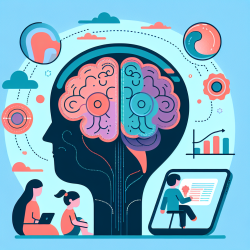Introduction
In the realm of speech-language pathology, understanding the neurological underpinnings of language acquisition is crucial. A recent study, "Auditory Cortex Asymmetry Associations with Individual Differences in Language and Cognition," sheds light on how structural differences in the brain can impact language development. This research provides valuable insights for practitioners aiming to enhance therapeutic outcomes for children.
Key Findings
The study utilized data from the Adolescent Brain Cognitive Development (ABCD) study, involving over 11,000 participants. It explored the hypothesis that asymmetry in the auditory cortex, particularly in the planum temporale, is associated with language abilities. The findings revealed modest but significant associations between leftward asymmetry and improved language performance, particularly in receptive vocabulary.
Implications for Practice
For practitioners, these findings underscore the importance of considering neurological factors when designing interventions. Here are some practical steps to integrate these insights into your practice:
- Assessment: Incorporate neurological assessments that can help identify structural asymmetries in the auditory cortex.
- Tailored Interventions: Design interventions that leverage a child's neurological strengths, focusing on enhancing receptive vocabulary skills.
- Gender-Specific Approaches: Recognize that boys and girls may exhibit different language development trajectories, and adjust interventions accordingly.
Encouraging Further Research
While this study provides a foundation, there is much more to explore. Practitioners are encouraged to delve deeper into how these asymmetries can be utilized to predict and improve language outcomes. Collaborating with researchers to conduct further studies can help refine our understanding and application of these findings.
Conclusion
The association between auditory cortex asymmetry and language abilities offers a promising avenue for enhancing therapeutic practices. By integrating these insights into clinical practice, practitioners can make data-driven decisions that improve outcomes for children.
To read the original research paper, please follow this link: Auditory Cortex Asymmetry Associations with Individual Differences in Language and Cognition.










